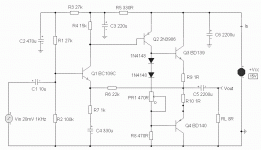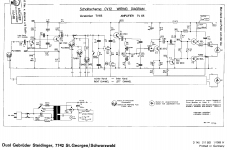I want to build a power amplifier using only germanium. It seems the key issue is thermal runaway.
I'm thinking something like this 2 watt (8ohm) design, except with possibly 2 or so transistors added for thermal stabilization. Using all 550mW (or whatever I can find pairs of) PNP and NPN trans. I also have a bunch of actual Ge power transistors in TO-3 packaging with gold plating meant for mabey 5 watts. I don't mind utilizing a +/- supply, 12VDC optimal.
The key to this unholy beast is drilling holes and mounting all of the transistors upside down inside a block of aluminum in fairly close proximity with a ton of thermal paste. (I believe)
Would something like this work? I know they did it somehow before silicon was invented. Academic and hobbyist fulfillment only, I know it's very inefficient.
I'm thinking something like this 2 watt (8ohm) design, except with possibly 2 or so transistors added for thermal stabilization. Using all 550mW (or whatever I can find pairs of) PNP and NPN trans. I also have a bunch of actual Ge power transistors in TO-3 packaging with gold plating meant for mabey 5 watts. I don't mind utilizing a +/- supply, 12VDC optimal.
The key to this unholy beast is drilling holes and mounting all of the transistors upside down inside a block of aluminum in fairly close proximity with a ton of thermal paste. (I believe)
Would something like this work? I know they did it somehow before silicon was invented. Academic and hobbyist fulfillment only, I know it's very inefficient.
Attachments
Early Ge transistors were mainly PNP so transformer-based class B was a common approach - if you can only source one polarity of transistor this is an approach (though you might have to make your own transformers  .
.
Given the scarcity of Ge diodes for thermal compensation I'd suggest using a Vbe multiplier for bias voltage, more flexible than a diode stack. Note that the change in Vbe with temperature doesn't depend much on the type of semiconductor, its fundamental physics, so a 2 Ge output stage needs 2 Ge diodes for compensation or approx 2 x multiplied Ge Vbe.
The block of Al is a good idea, the thermal mass will help stabilize things, but I'm not sure how good early transistor packages are thermally.
Given the scarcity of Ge diodes for thermal compensation I'd suggest using a Vbe multiplier for bias voltage, more flexible than a diode stack. Note that the change in Vbe with temperature doesn't depend much on the type of semiconductor, its fundamental physics, so a 2 Ge output stage needs 2 Ge diodes for compensation or approx 2 x multiplied Ge Vbe.
The block of Al is a good idea, the thermal mass will help stabilize things, but I'm not sure how good early transistor packages are thermally.
You can still find AD161/162 , but best audiophile amp with germanium was the Dual CV12. Only 2.5w but the first audiophile series of Dual.Dual CV 12 Verstarker Vintage in Baden-Wurttemberg - Schwaigern | Weitere Audio & Hifi Komponenten gebraucht kaufen | eBay Kleinanzeigen
Attachments
Last edited:
OH phoack yeah! Somebody finally doing something vintage. All power (well maybe low power) to ya! But I recommend sticking to a more "assymmetrical" design, meaning, one polarity on the output and use interstage transformer coupling. I can provide examples, but you can find them on the net, anyway. Finding matched Ge pairs will be difficult and expensive.
> issue is thermal runaway.
The issue with Ge is *leakage*. Nailing all the parts together will not help. Si does not leak (enough to bother us) so Si-era tips do not apply.
Read-read-read!!!! Thousands of all-Ge power amps were made. Scour the hi-fi schematics boards. Also GE Transistor Manual. The magic is not lost, only forgotten.
The issue with Ge is *leakage*. Nailing all the parts together will not help. Si does not leak (enough to bother us) so Si-era tips do not apply.
Read-read-read!!!! Thousands of all-Ge power amps were made. Scour the hi-fi schematics boards. Also GE Transistor Manual. The magic is not lost, only forgotten.
- Status
- This old topic is closed. If you want to reopen this topic, contact a moderator using the "Report Post" button.

